Evaluating the Impact of Vertical Green Systems on Building Temperature Regulation: Effects of Shading Density and Proximity
Abstract
1. Introduction
2. Experimental Setup and Methodology
- Experimental Group: Vertical greening systems were installed on the west side of the buildings. The experiments examined how the distance between the vertical greening system and the building, as well as various levels of green coverage, affected indoor temperature changes. Experimental conditions included the following:
- (1)
- Distance: Vertical greening systems placed 50 cm and 100 cm away from the building.
- (2)
- Coverage: Three levels of green coverage were assessed, namely, below 70%, 70–95%, and above 95%.
- Control Group: This group used the same building materials and design as the experimental group but did not include any vertical greening systems. It served as a baseline for comparison to synchronize the collection of experimental data.
- Temperature Sensor Deployment: Thirty temperature sensors were installed inside each building to monitor changes in indoor temperature.
- Meteorological Monitoring Stations: An outdoor environmental meteorological station was set up. Additionally, a mini-environmental meteorological station was installed between the vertical greening system and the building in the experimental group. The corresponding monitoring equipment was also placed in the same location for the control group.
- Data Collection: Data collected included surface temperature, environmental humidity, radiant heat, and changes in indoor temperature. The data were analyzed statistically based on different experimental conditions (e.g., distances of 50 cm and 100 cm from the building and varying levels of green coverage) to assess the impact of these factors on the building’s energy-saving effects.
- Thermal Imaging: A thermal imaging camera was used to assess the heat distribution and thermal effects on the west-facing walls under different vertical greening distances and shading levels. This analysis further examined how varying conditions of vertical greening influenced temperature changes on building walls.
- This study used the Wilcoxon Signed-Rank Test to analyze the cooling effects of different greening system schemes. The test compares temperature differences between the experimental group (with greening systems) and the control group (without greening systems), determining whether the temperature reduction is statistically significant.
2.1. Vertical Green System Setting
2.2. Vertical Green System Vegetation Setting
2.3. Season and Temperature Selection
2.4. Statistical Analysis Method
2.4.1. Statistical and Testing Method Explanation
2.4.2. Theoretical Basis for Test Method Selection
- (1)
- Nature of the Data: The data in this study consist of temperature differences between the experimental and control groups at the same time points, representing paired sample data. The temperature data may not follow a normal distribution, and traditional parametric tests (such as paired sample t-tests) are less accurate for non-normally distributed data. Therefore, the Wilcoxon Signed-Rank Test was chosen.
- (2)
- Characteristics of the Wilcoxon Test: The Wilcoxon Signed-Rank Test does not require assumptions about the normality of the data, making it suitable for skewed or small sample data with high robustness. The test compares the differences between each paired sample, ranks the absolute values of the differences, and sums the positive ranks and negative ranks, allowing the test of whether significant differences exist between the two groups.
- (3)
- Hypothesis Setup:
2.4.3. Statistical Analysis Process
- (1)
- Difference Calculation: For each time point, calculate the paired temperature differences between the experimental and control groups, recording positive and negative signs.
- (2)
- Ranking: Rank the absolute values of the differences, assigning ranks and noting the positive and negative ranks.
- (3)
- Test Statistic Calculation: Compute the sum of the positive and negative ranks and obtain the test statistic (W value) and p-value using statistical software.
- (4)
- Result Interpretation: Based on the test results (p-value and significance level α), determine whether to reject the null hypothesis.
2.4.4. Theoretical Significance of Test Results
3. Experimental Instruments and Monitoring Equipment
3.1. Instruments and Equipment
- (1)
- Environmental Meteorological Stations: These stations provide macro climate conditions for the experimental site, including atmospheric temperature, relative humidity, wind direction, wind speed, and solar radiation, Figure 8a. Data from these stations are collected using a CR200 data logger, manufactured by Campbell Scientific, located in Logan, UT, USA. This data serves as the basis for comparing the experimental and control groups (Figure 8b).
- (2)
- Mini-Environmental Monitoring Stations: Located on the west-facing exterior walls of both the experimental and control buildings, these stations compare environmental parameter changes under conditions with and without the vertical greening system, Figure 8c. They record atmospheric temperature, relative humidity, wind direction, wind speed, and solar radiation, as well as surface temperatures of the west-facing walls and the vertical greening system, Figure 8d. This setup helps to clearly understand the impact of the vertical greening system on building wall temperatures.
- (3)
- Indoor Temperature Sensors: A thermocouple sensor consists of a loop made of two conductors with different properties. When the junctions of the two metals are at different temperatures, a temperature difference is created, which generates a thermoelectric potential. This, in turn, produces a measurable voltage that can be used to determine the temperature. In this study, thirty sensors were placed 80 cm from the west wall to accurately monitor indoor temperature variations, Figure 8e.
- (4)
- Surfer simulation software was developed by Golden Software as Surfer v26. It features a highly professional gridding design, enabling the rapid creation of professional 2D and 3D images. Surfer can use XYZ data to generate various contour maps and 3D grid maps, and is widely used in terrain modeling, landscape visualization, surface analysis, and watershed management. During the research process, data were collected through temperature sensors and visualized using Surfer 8.0 software, Figure 8f, producing detailed charts of indoor temperature changes. This analysis further evaluates the effect of the vertical greening system on indoor temperatures.
3.2. Data Presentation Methodology
- (1)
- Data Collection and Organization: Collect and organize data from environmental meteorological stations, including atmospheric temperature and solar radiation, as well as surface temperature data from mini-environmental monitoring stations on the exterior walls and the vertical greening systems. This was performed weekly.
- (2)
- Temperature Variation Analysis: Analyze how the collected data affect the temperature changes at the 30 indoor points.
- (3)
- Statistical Analysis: Perform statistical analysis on the data to evaluate the benefits and performance of different vertical greening system distances.
4. Results and Discussion
4.1. Vertical Green System at 50 cm Distance and 70% Opacity
4.1.1. Temperature Variation and Solar Radiation Variation for VGS with Distance 50 cm and Opacity 70%
4.1.2. Vertical Green System at 50 cm Distance and 70% Opacity: Indoor Temperature Variations
Daily Temperature Variation in the Experimental and Control Groups
4.2. Vertical Green System at 50 cm Distance and 95% Opacity
4.2.1. Temperature Variation and Solar Radiation Variation for VGS with Distance 50 cm and Opacity 95%
4.2.2. Vertical Green System at 50 cm Distance and 95% Opacity: Temperature Variation Between Experimental and Control Groups
Daily Temperature Variation in the Experimental and Control Groups
4.3. Vertical Green System at 100 cm Distance and 70% Opacity
4.3.1. Temperature Variation and Solar Radiation Variation for VGS with Distance 100 cm and Opacity 70%
4.3.2. Vertical Green System at 100 cm Distance and 70% Opacity: Temperature Variation Between Experimental and Control Groups
Daily Temperature Variation in the Experimental and Control Groups
4.4. Vertical Green System at 100 cm Distance and 95% Opacity
4.4.1. Temperature Variation and Solar Radiation Variation for VGS with Distance 100 cm and Opacity 95%
4.4.2. Vertical Green System at 100 cm Distance and 95% Opacity: Temperature Variation Between Experimental and Control Groups
Daily Temperature Variation in the Experimental and Control Groups
4.5. Vertical Green System Statistical Analysis
4.5.1. Statistical Analysis of Air Temperature
4.5.2. Discussion Based on the Statistical Analysis
- At 50 cm distance and 70% opacity: This configuration demonstrated the smallest maximum temperature difference of 9.39 °C, indicating significant cooling effects with a narrower temperature range compared to the other setups.
- At 50 cm distance and 95% opacity: The maximum temperature difference increased to 13.21 °C, but the cooling effect remained notable. However, the temperature range was larger than in the 70% opacity configuration.
- At 100 cm distance and 70% opacity: This setup had a maximum temperature difference of 13.42 °C, demonstrating good cooling effects, although it showed slightly lower efficiency compared to the 50 cm distance configurations.
- At 100 cm distance and 95% opacity: With the highest maximum temperature difference of 15.20 °C, this scheme displayed the greatest temperature variation, but it still provided significant cooling.
- At 50 cm distance and 70% opacity: This setup exhibited the smallest maximum temperature difference (9.39 °C) and notable cooling effects. However, the median temperature of 31.25 °C was higher than that of other configurations, suggesting a slightly weaker overall cooling performance.
- At 50 cm distance and 95% opacity: Despite the higher maximum temperature difference of 13.21 °C, this configuration achieved the most significant cooling effect, with a median temperature of 33.41 °C, making it the best overall choice.
- At 100 cm distance and 70% opacity: With a maximum temperature difference of 13.42 °C, this setup provided a cooling effect that was slightly less effective than the 50 cm distance and 95% opacity setup.
- At 100 cm distance and 95% opacity: This configuration, with the highest maximum temperature difference (15.20 °C), showed the largest temperature spread but had the weakest cooling performance compared to the other options.
5. Conclusions
5.1. Ambient Influence
- (1)
- Effectiveness of Shading: Vertical green systems (VGSs) are effective in reducing solar radiation. With a shading rate of 70%, the solar radiation dropped to 100–200 W/m2. For shading rates of 95% or higher, the solar radiation was reduced to below 50 W/m2, regardless of whether the VGS was positioned 100 cm or 50 cm from the building.
- (2)
- Temperature Reduction: Higher shading density enhances temperature control. Between 13:00 and 16:00, during peak sunlight, the temperature inside a VGS with a 70% shading rate was about 0.5–0.8 °C lower compared to the control. When the shading rate reached 95% or higher, the temperature inside the VGS was reduced by 0.5–2.1 °C compared to the control without any VGS.
- (3)
5.2. Surface Temperature
- (1)
- Temperature Reduction: A vertical green system (VGS) with a shading rate of 95% significantly reduced surface temperatures during peak sun hours (13:00–16:00). Walls with this VGS configuration had surface temperatures averaging 5–12 °C lower than those of control walls, with temperature differences ranging from 10 to 31 °C.
- (2)
- Distance from Wall: Analysis shows that a VGS positioned 100 cm from the wall was more effective than one positioned 50 cm away. During peak hours, the 100 cm distance effectively blocked more solar heat from reaching the wall, providing a clear advantage over the 50 cm distance, particularly between 14:00 and 16:00.
5.3. Interior Temperature
- (1)
- Temperature Difference: The most significant temperature difference between the experimental and control groups occurred with a VGS positioned 100 cm away from the wall and a shading rate of 95%, reaching up to 6.3 °C. Typically, with 95% shading, the temperature difference was around 4–5 °C, whereas with a 70% shading rate, it averaged 2–3 °C.
- (2)
- Temperature Stability: Simulation results using Surfer 8.0 demonstrated that the VGS effectively reduced temperature fluctuations, maintaining a more stable interior temperature. The VGS setup showed a variation of within 1 °C, while the control group experienced nearly 4 °C of variation during peak times.
- (3)
- The statistical analysis reveals that while changes in distance (such as between 50 cm and 100 cm with 95% opacity) slightly enhance the cooling effects, the 50 cm distance with 95% opacity still yields the best overall cooling performance. This finding suggests that, when designing vertical green systems, carefully selecting the optimal combination of shading rate (e.g., 95% opacity) and distance (e.g., 50 cm) can achieve the most effective temperature regulation, particularly in reducing solar radiation and improving indoor temperature stability.
- (4)
- The study then investigates the effects of the shading rate and distance of vertical green systems on indoor cooling performance, employing a detailed 2 × 2 experimental design. The results show that opacity is the key factor influencing cooling performance, with 70% opacity outperforming 95% opacity in cooling effectiveness. Specifically, under both 50 cm and 100 cm distance conditions, the 70% opacity group demonstrates significant cooling benefits, as indicated by a higher temperature difference. However, variations in distance have a relatively minor impact on cooling performance. In both opacity conditions (70% and 95%), changes in distance from 50 cm to 100 cm produce limited effects on indoor temperature, underscoring the dominant role of opacity in regulating cooling performance.
Author Contributions
Funding
Data Availability Statement
Conflicts of Interest
References
- Collins, M.; Stocker, T.F.; Qin, D.; Plattner, G.K.; Tignor, M.M.B.; Allen, S.K.; Boschung, J.; Nauels, A.; Xia, Y.; Bex, V.; et al. Climate Change 2013: The Physical Science Basis. In Working Group I Contribution to the IPCC Fifth Assessment Report; Chapter 12: Long-Term Climate Change: Projections, Commitments and Irreversibility (Section 12.3.1.3); Cambridge University Press: Cambridge, UK, 2013; pp. 1045–1047. [Google Scholar]
- Tamzi, A. The UN Convention on International Watercourses as a Framework for Avoidance and Settlement of Waterlaw Disputes. Leiden J. Int. Law 1998, 11, 441–473. [Google Scholar] [CrossRef]
- Gupta, J. Leadership in the Climate Regime: Inspiring the Commitment of Developing Countries in the Post-Kyoto Phase. Rev. Eur. Comp. Int. Environ. Law 1998, 7, 180–190. [Google Scholar] [CrossRef]
- National Intelligence Council (NIC), United States Government. Global Trends 2025. Popul. Dev. Rev. 2009, 35, 209–214. [Google Scholar] [CrossRef]
- U.S. Energy Information Administration. U.S. Energy Information. Available online: https://www.eia.gov/energyexplained/?page=us_energy_home (accessed on 21 September 2024).
- U.S. Environmental Protection Agency. Overview of Greenhouse Gases. Available online: https://www.epa.gov/ghgemissions/overview-greenhouse-gases (accessed on 21 September 2024).
- Better Buildings Solution Center. Available online: https://betterbuildingssolutioncenter.energy.gov/ (accessed on 21 September 2024).
- National Taiwan University. Open Energy Review. Available online: https://rsprc.ntu.edu.tw/web/research/research_in.jsp?lang=en&rp_id=RP1729239776933 (accessed on 26 January 2025).
- Taiwan Climate Change Adaptation Platform. Available online: https://tccip.ncdr.nat.gov.tw/ds_05_03.aspx (accessed on 21 September 2024).
- Central Weather Bureau. Taiwan Climate Change Statistical Report 1897–2008; Central Weather Bureau: Taipei, Taiwan, 2009.
- Liu, S.C.; Wang, C.H.; Shiu, C.J.; Chang, H.W.; Hsiao, C.K.; Liaw, S.H. Reduction in Sunshine Duration over Taiwan: Causes and Implications. Terr. Atmos. Ocean. Sci. 2002, 13, 523–546. [Google Scholar] [CrossRef] [PubMed]
- Intergovernmental Panel on Climate Change (IPCC). Climate Change 2001: The Scientific Basis; Houghton, J.T., Ding, Y., Griggs, D.J., Noguer, M., Van der Linden, P.J., Dai, X., Maskell, K., Johnson, C.A., Eds.; Cambridge University Press: Cambridge, UK, 2001. [Google Scholar]
- Taichung City Government. Research on Urban Cooling Strategies in Taichung City; Taichung City Government: Taichung City, Taiwan, 2024.
- Wang, P.; Wong, Y.H.; Tan, C.Y.; Li, S.; Chong, W.T. Vertical Greening Systems: Technological Benefits, Progresses and Prospects. Sustainability 2022, 14, 12997. [Google Scholar] [CrossRef]
- Seyam, S. The impact of greenery systems on building energy: Systematic review. J. Build. Eng. 2019, 26, 100887. [Google Scholar] [CrossRef]
- Bevilacqua, P. The effectiveness of green roofs in reducing building energy consumption across different climates: A summary of literature results. Renew. Sustain. Energy Rev. 2021, 151, 111523. [Google Scholar] [CrossRef]
- Khan, I.H.; Munawer, T. A Systematic Review of Economic Sustainability of Vertical Greenery Systems for Buildings. Constr. Econ. Build. 2024, 24, 119–143. [Google Scholar] [CrossRef]
- Rupasinghe, H.T.; Halwatura, R.U. Benefits of implementing vertical greening in tropical climates. Urban For. Urban Green. 2020, 53, 126708. [Google Scholar] [CrossRef]
- Wong, N.H.; Tan, A.Y.K.; Chen, Y.; Sekar, K.; Tan, P.Y.; Chan, D.; Chiang, K.; Wong, N.C. Thermal evaluation of vertical greenery systems for building walls. Build. Environ. 2010, 45, 663–672. [Google Scholar] [CrossRef]
- Manouchehri, M.; López, J.S.; López, M.V. Sustainable Design of Vertical Greenery Systems: A Comprehensive Framework. Sustainability 2024, 16, 3249. [Google Scholar] [CrossRef]
- Haggag, M.; Hassan, A.; Elmasry, S. Experimental study on reduced heat gain through green facades in a high heat load climate. Energy Build. 2014, 82, 668–674. [Google Scholar] [CrossRef]
- Susorova, I.; Angulo, M.; Bahrami, P.; Stephens, B. A model of vegetated exterior facades for evaluation of wall thermal performance. Build. Environ. 2013, 67, 1–13. [Google Scholar] [CrossRef]
- Scarpa, M.; Mazzali, U.; Peron, F. Modeling the energy performance of living walls: Validation against field measurements in temperate climate. Energy Build. 2014, 79, 155–163. [Google Scholar] [CrossRef]
- Hao, X.; Lin, Y.; Tan, H.; Yang, K. Experimental investigation on the thermal performance of a vertical greening system with green roof in wet and cold climates during winter. Energy Build. 2019, 183, 105–117. [Google Scholar]
- Chen, Q.; Li, B.; Liu, X. An experimental evaluation of the living wall system in hot and humid climate. Energy Build. 2013, 61, 298–307. [Google Scholar] [CrossRef]
- Stav, Y.; Lawson, G. Vertical vegetation design decisions and their impact on energy consumption in subtropical cities. WIT Trans. Ecol. Environ. 2012, 155, 489–500. [Google Scholar]
- Dledjig, R.; Bozonnet, E.; Belarbi, R. Analysis of thermal effects of vegetated envelopes: Integration of a validated model in building energy simulation program. Energy Build. 2015, 86, 93–103. [Google Scholar] [CrossRef]
- Farrokhirad, E.; Rigillo, M.; Köhler, M.; Perini, K. Optimising vertical greening systems for sustainability: An integrated design approach. Int. J. Sustain. Energy 2024, 43, 1. [Google Scholar] [CrossRef]
- Carlos, J.S. Simulation assessment of living wall thermal performance in winter in the climate of Portugal. Build. Simul. 2014, 8, 3–11. [Google Scholar] [CrossRef]
- Peña-García, A.; López, J.C.; Grindlay, A.I. Decrease of energy demands of lighting installations in road tunnels based on the forestation of portal surroundings with climbing plants. Tunn. Undergr. Space Technol. 2015, 46, 111–115. [Google Scholar] [CrossRef]

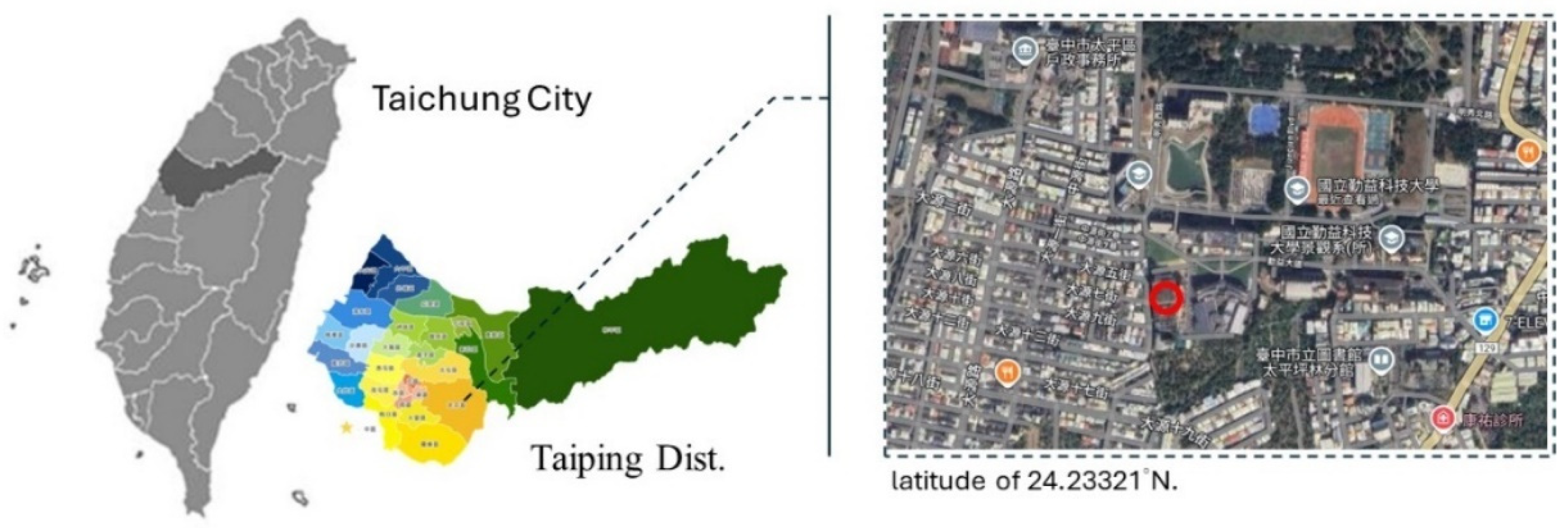
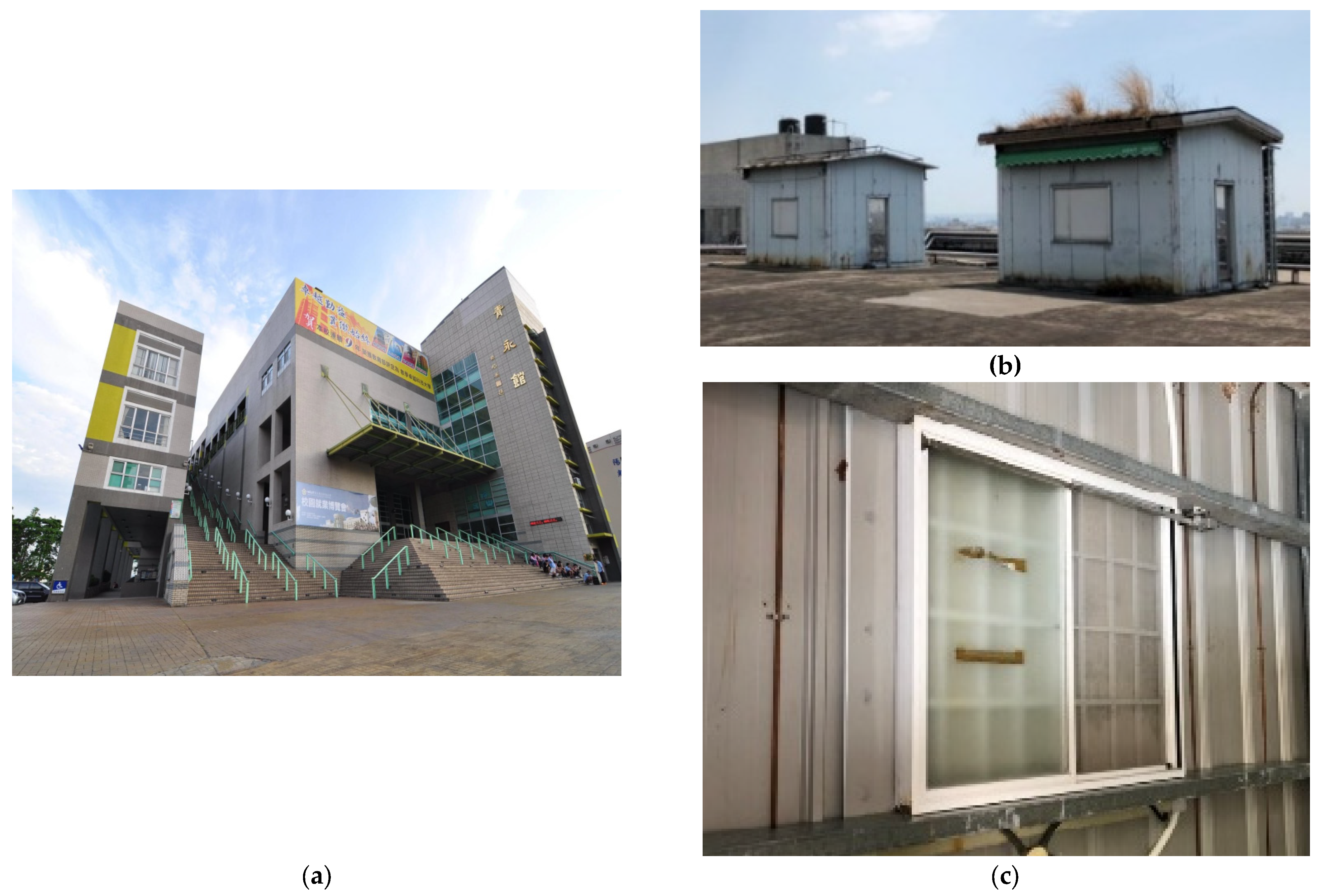
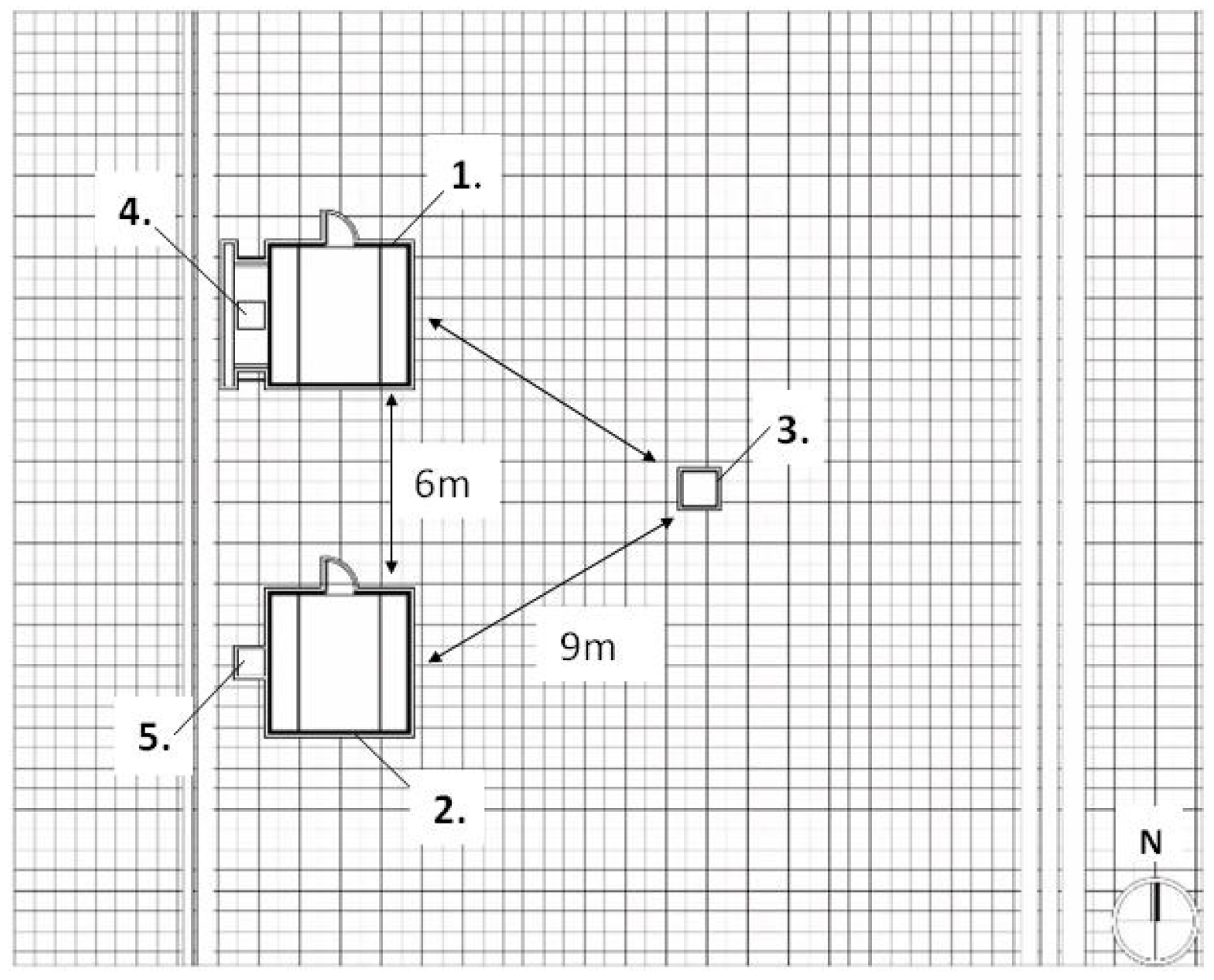
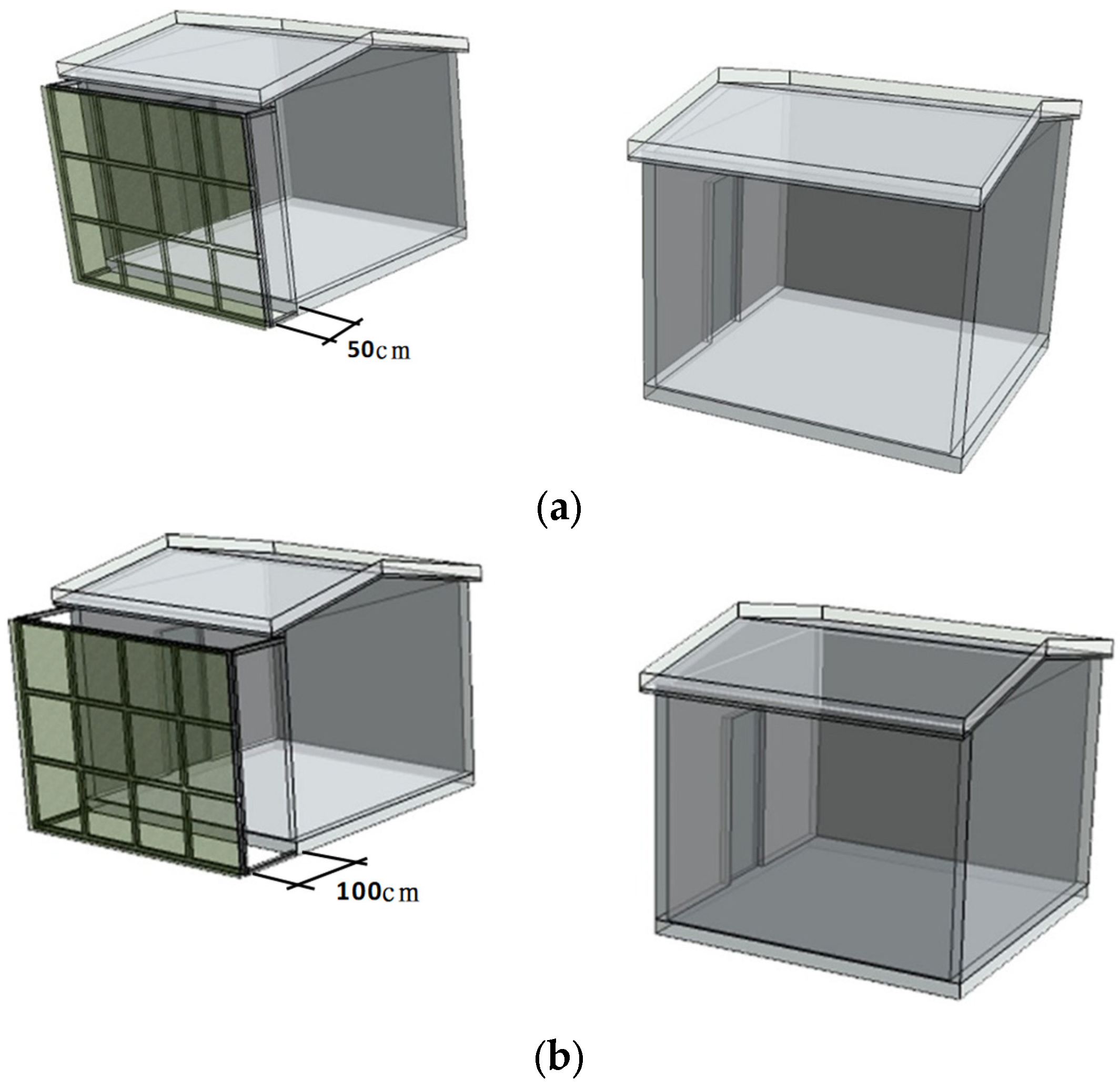


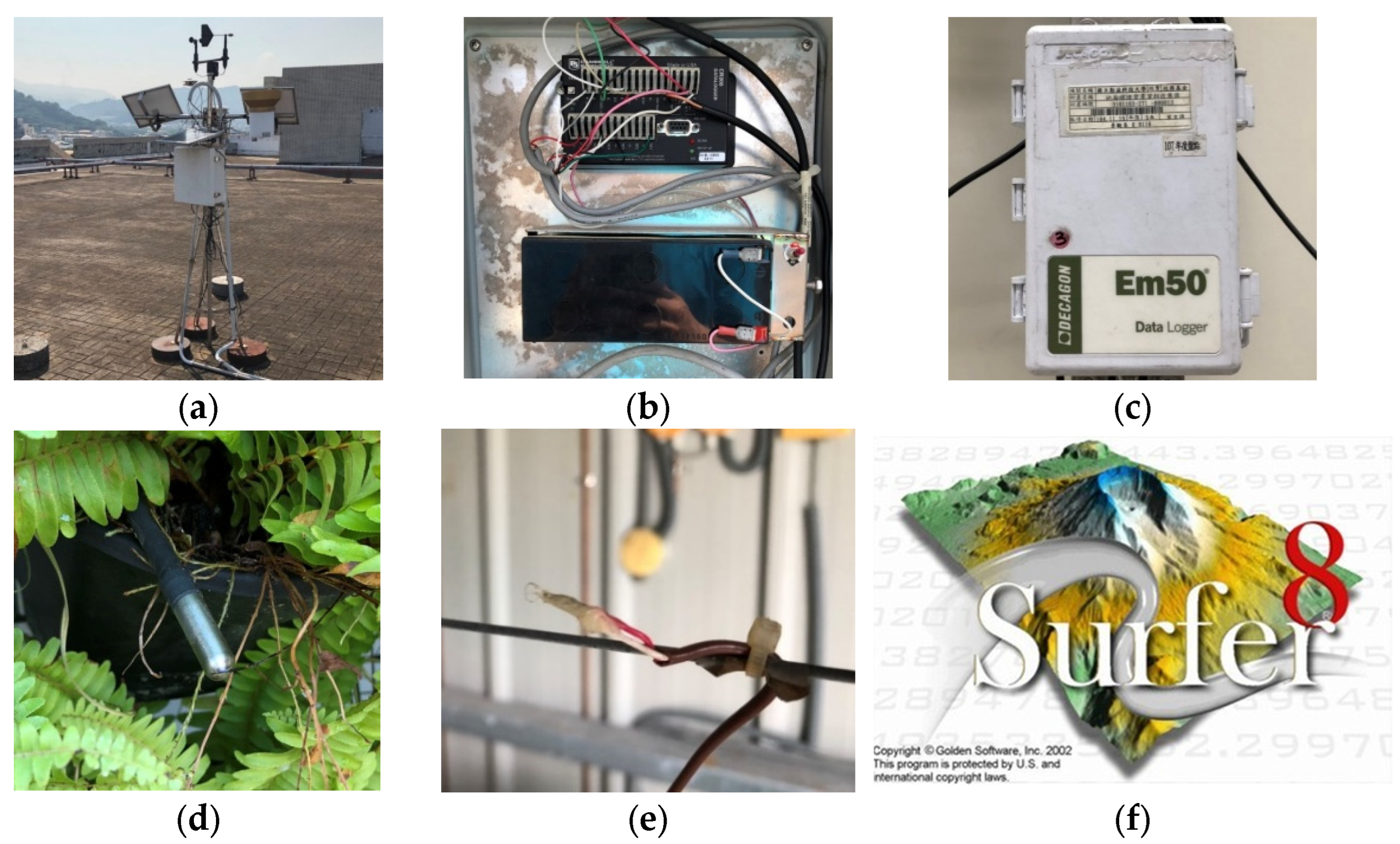

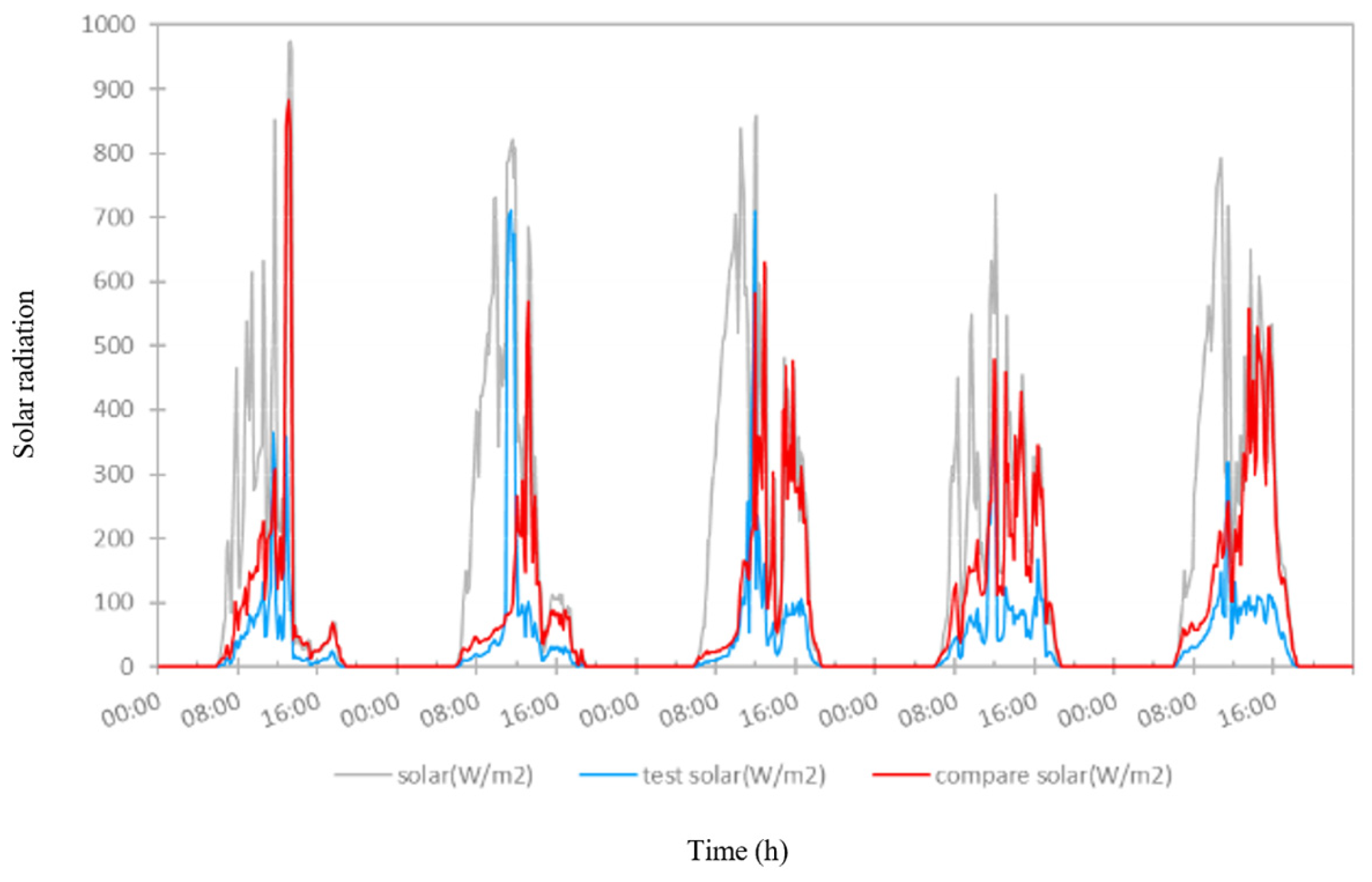

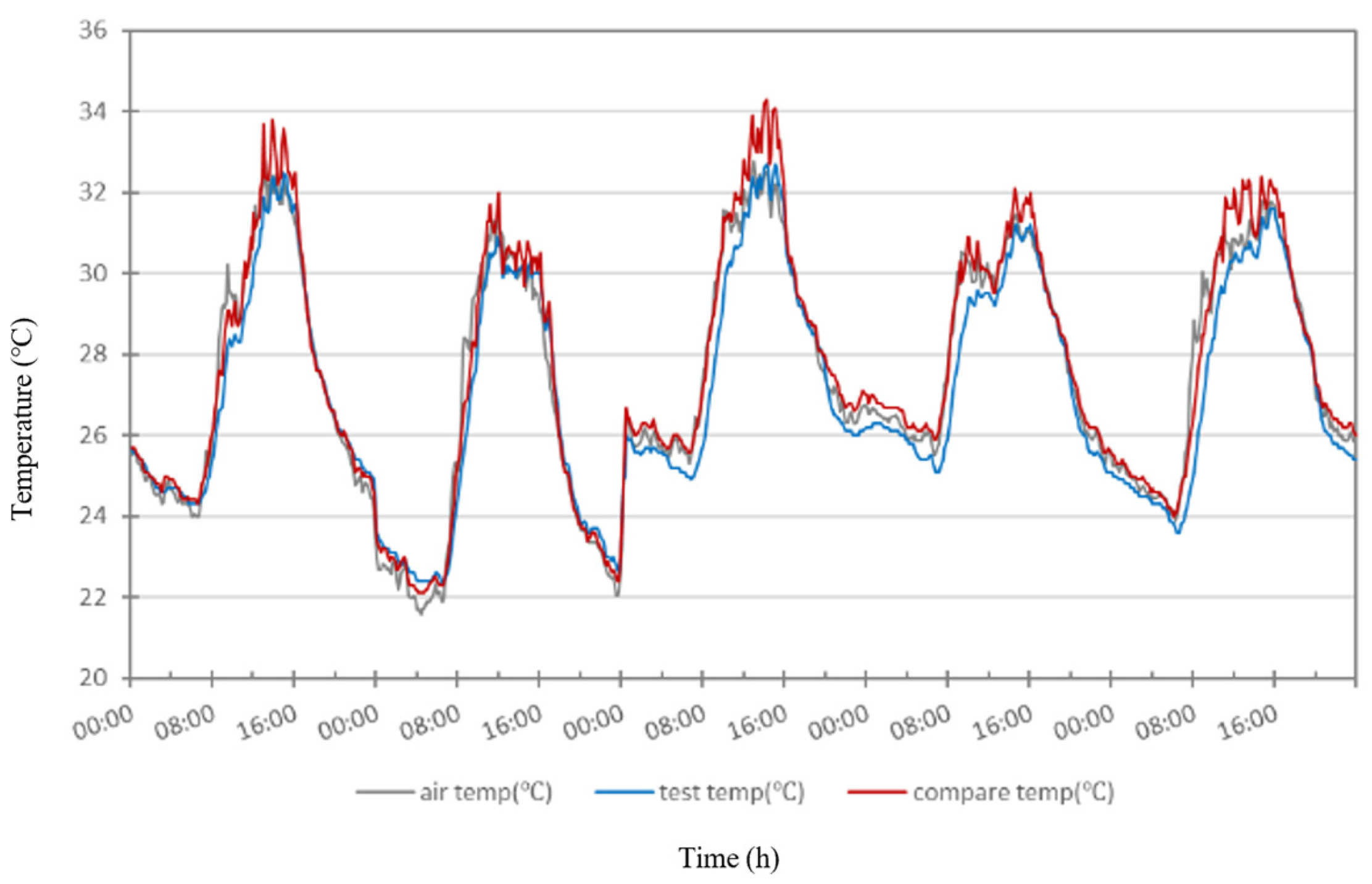
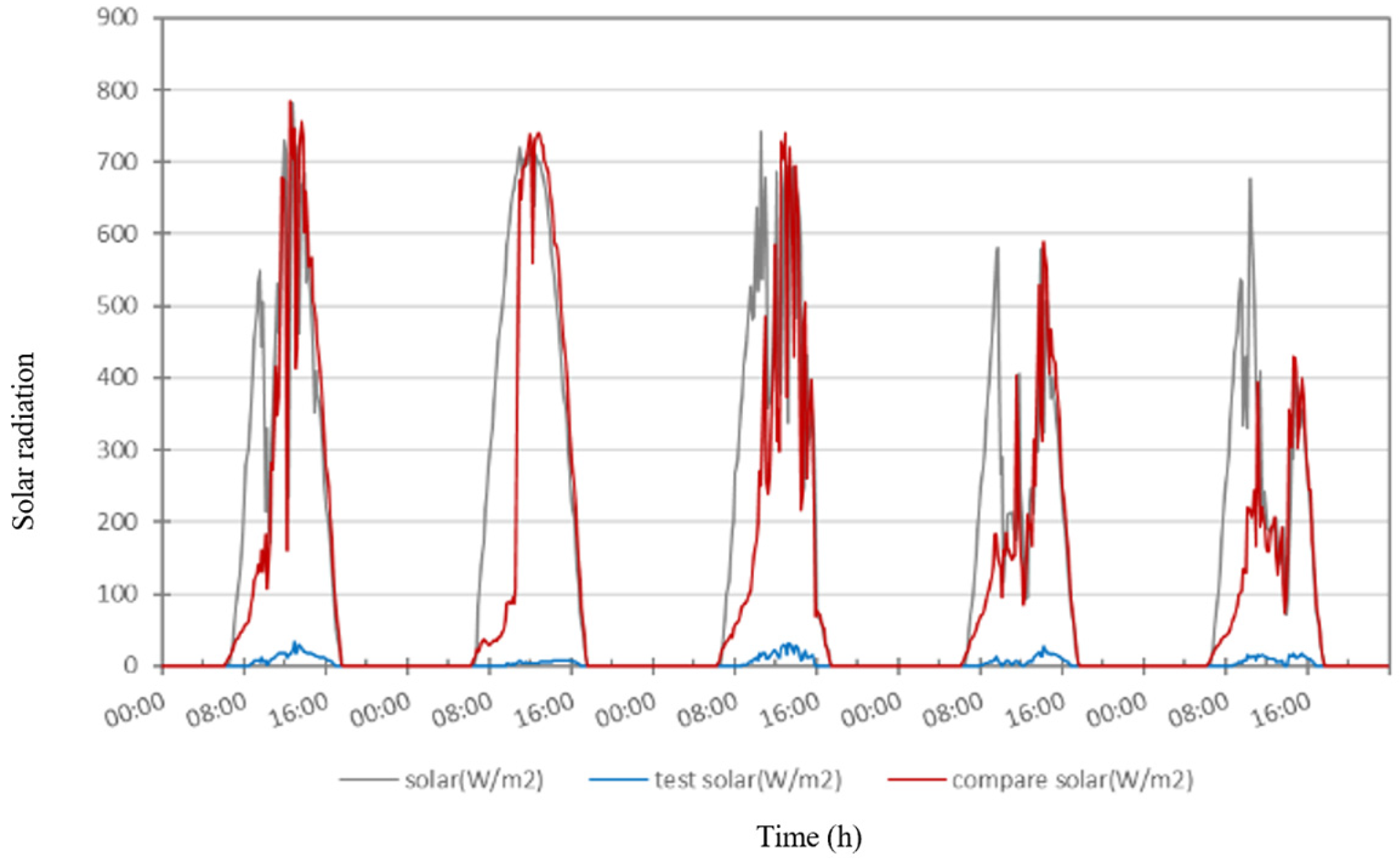

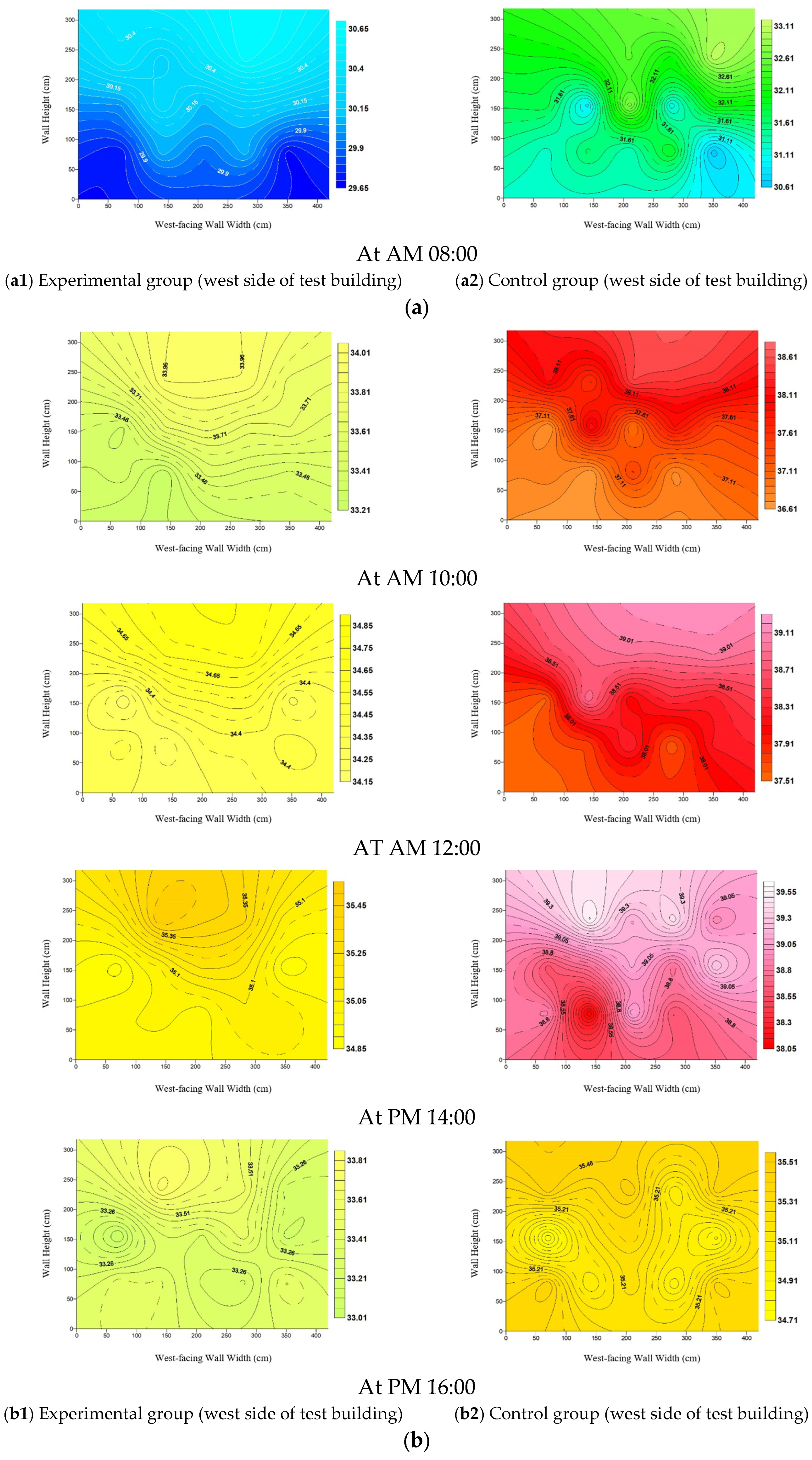
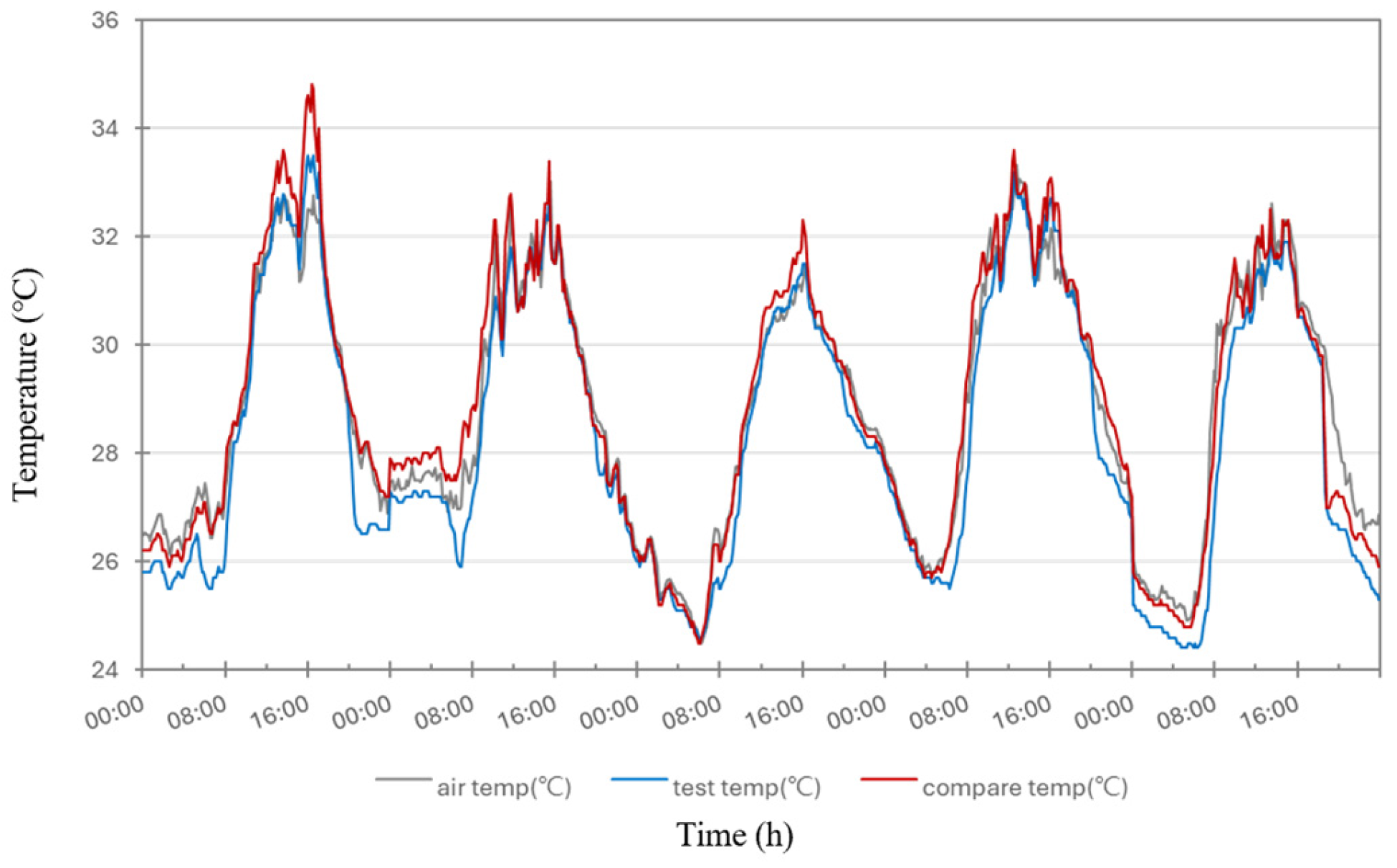
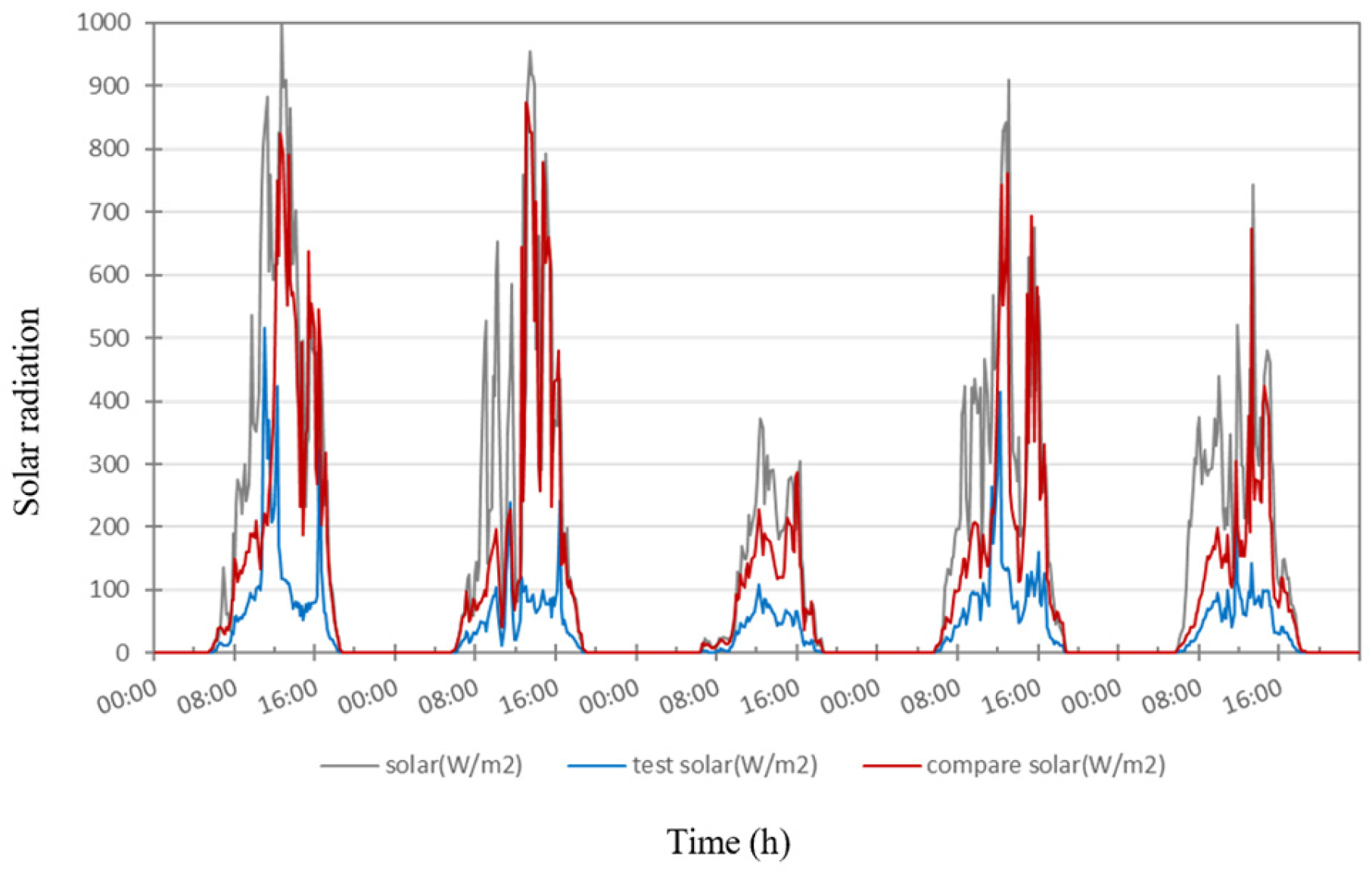
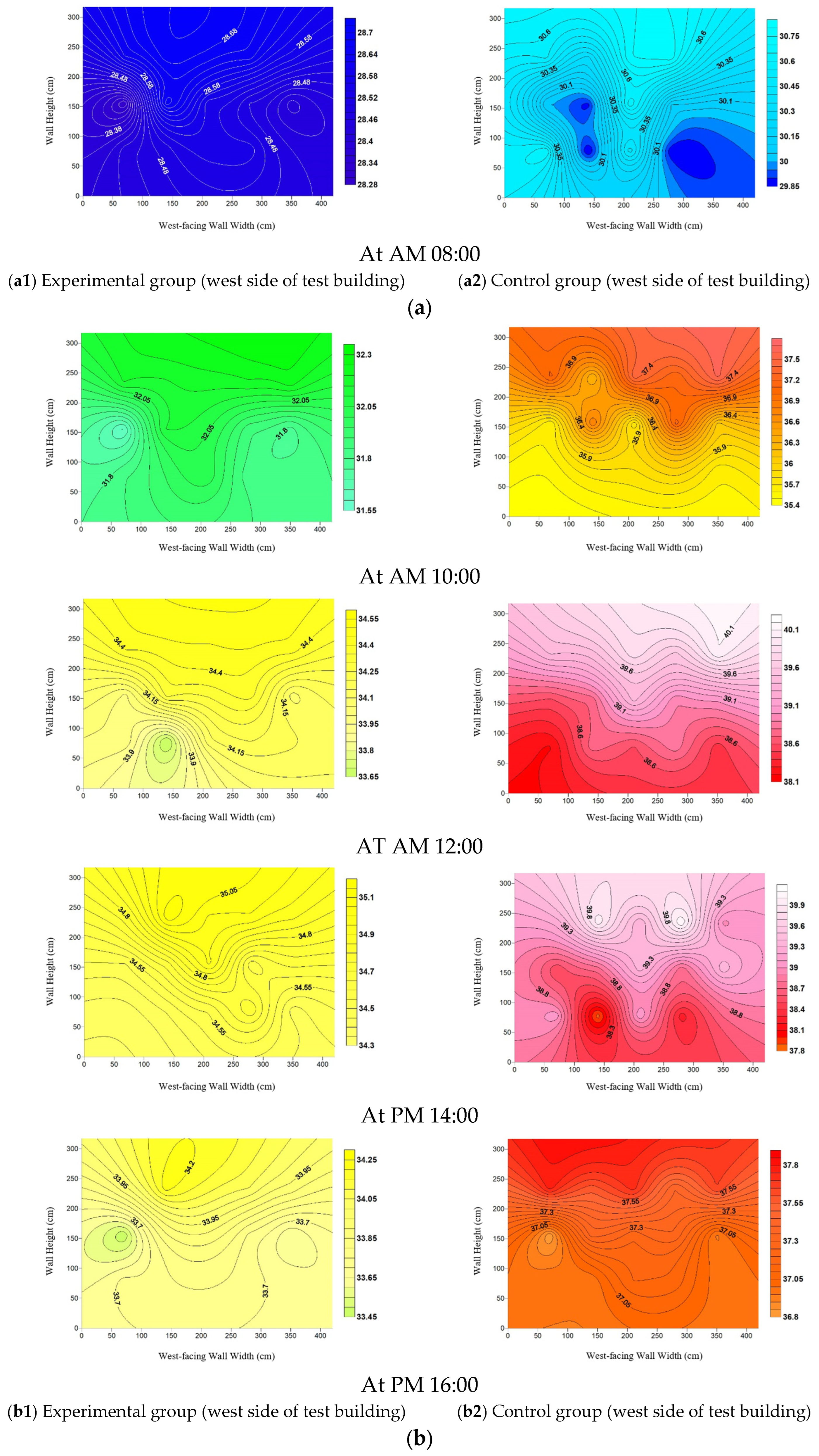
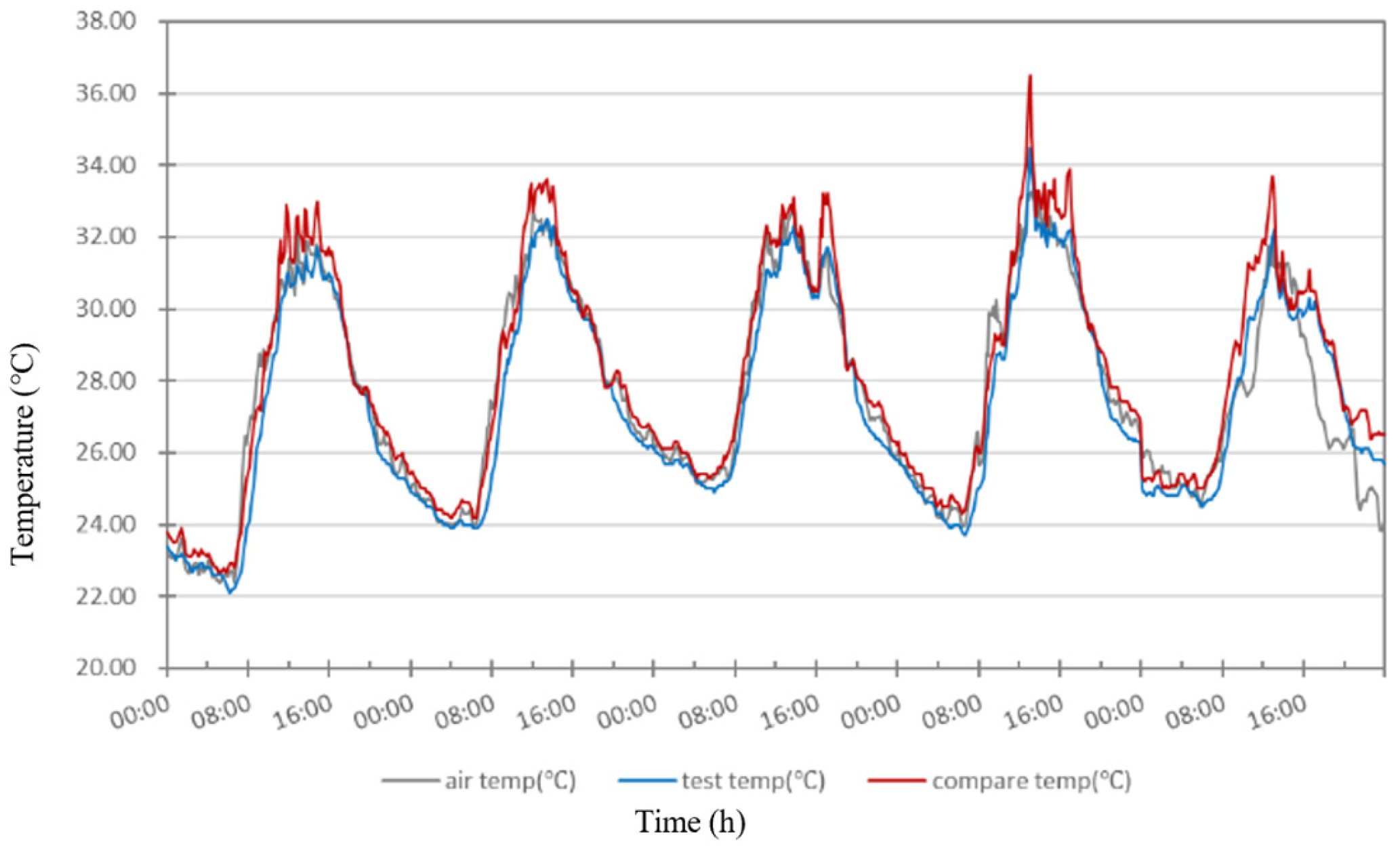
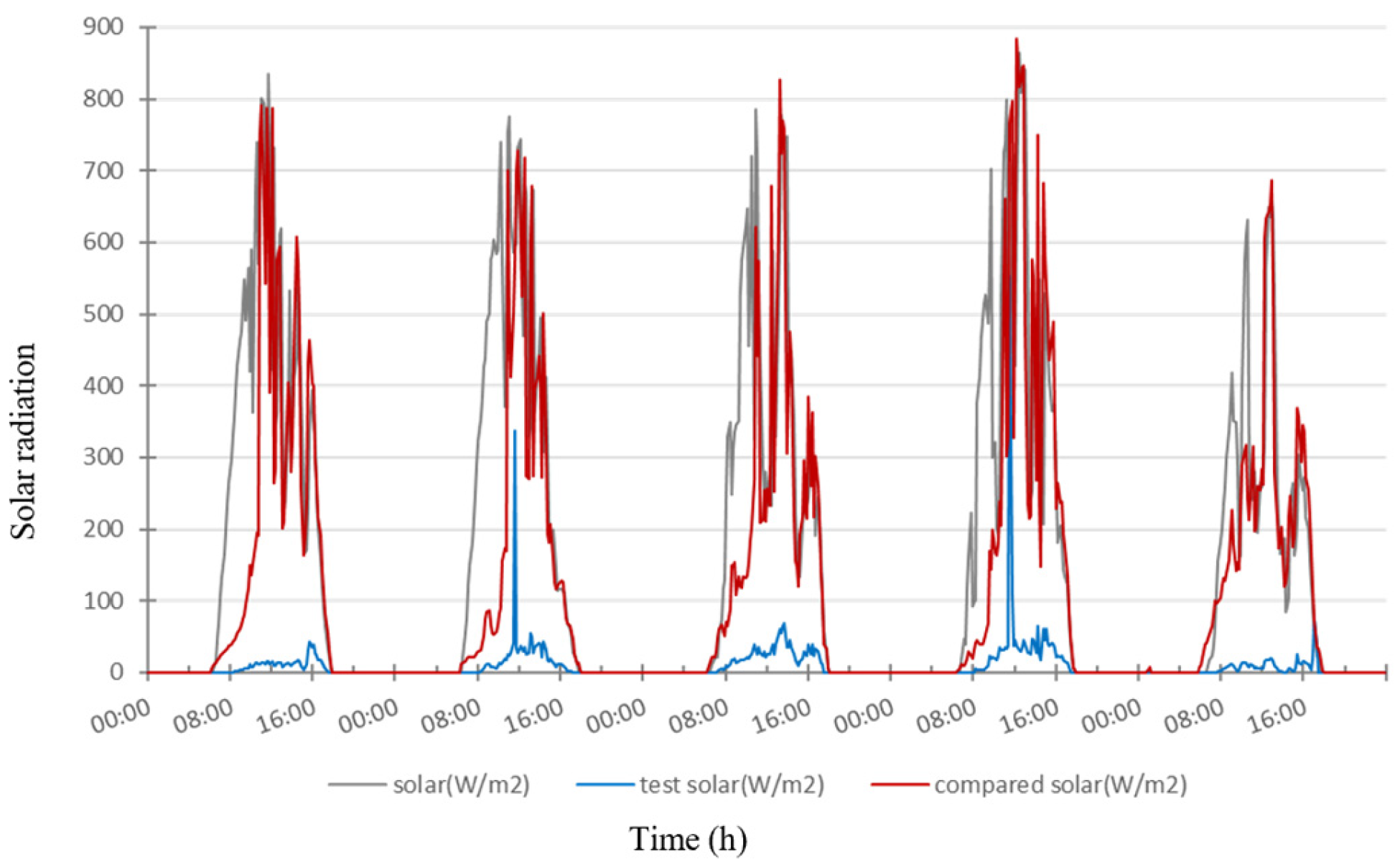
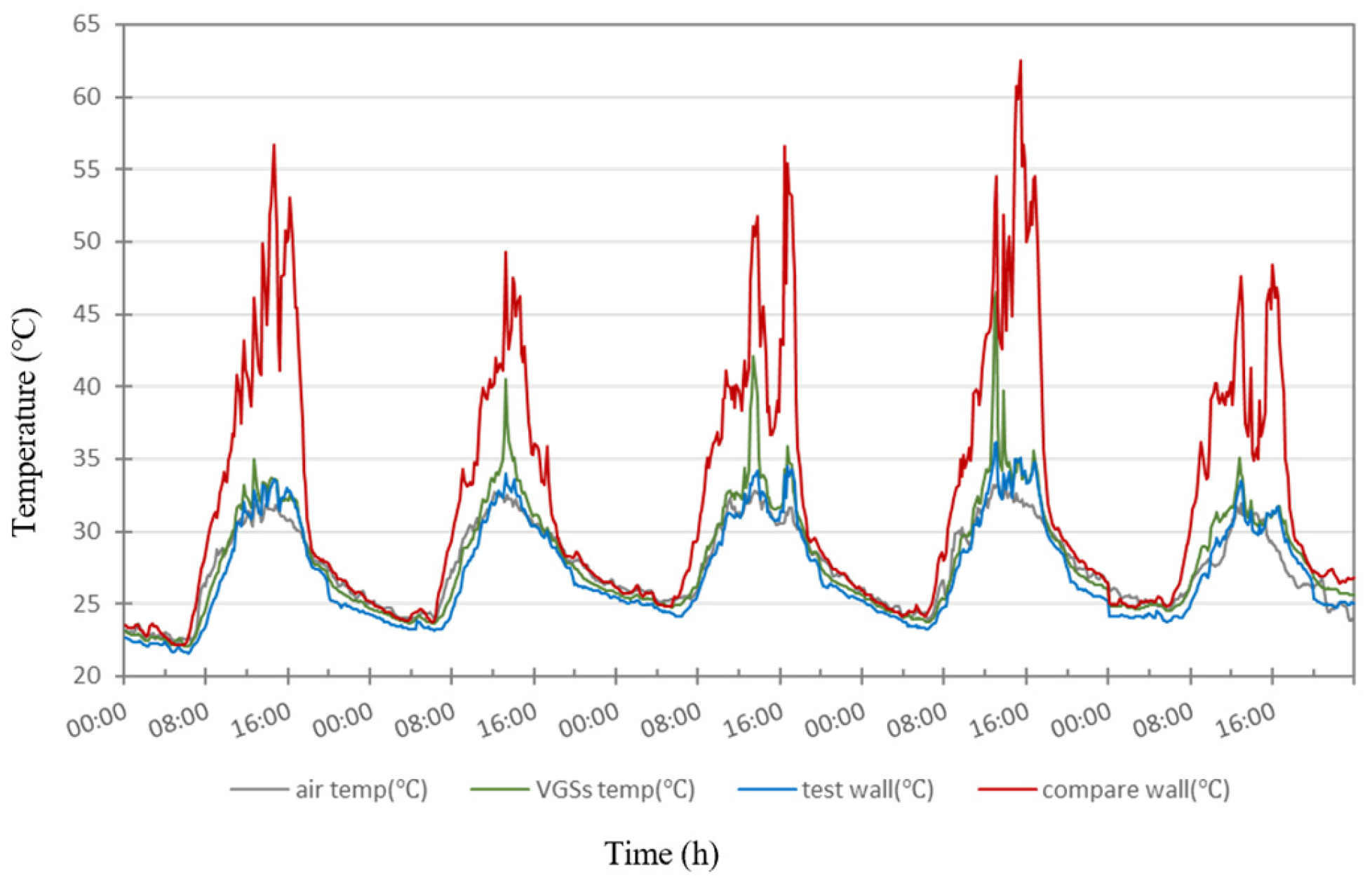
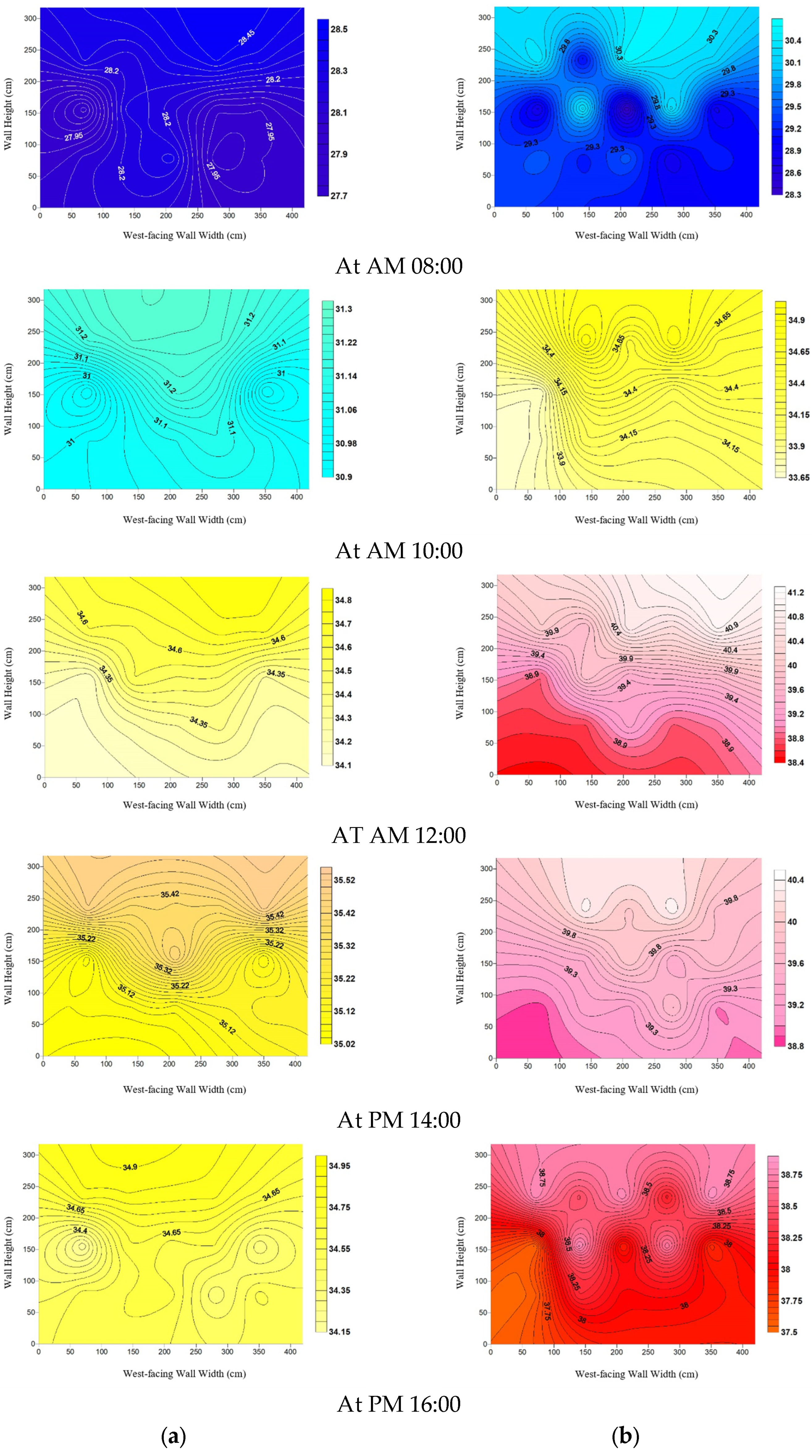
| Time | Extremes | Unit | Experimental Group West Side | Control Group West Side | Temperature Difference |
|---|---|---|---|---|---|
| 07:00 | Max | °C | 29.01 | 30.1 | 1.09 |
| Min | °C | 28.41 | 27.4 | −1.01 | |
| 08:00 | Max | °C | 30.99 | 33.1 | 2.11 |
| Min | °C | 30.53 | 31.1 | 0.57 | |
| 09:00 | Max | °C | 31.72 | 34.6 | 2.88 |
| Min | °C | 31.24 | 32.81 | 1.57 | |
| 10:00 | Max | °C | 32.34 | 35.5 | 3.16 |
| Min | °C | 32.15 | 33.7 | 1.55 | |
| 11:00 | Max | °C | 33.06 | 36.15 | 3.09 |
| Min | °C | 32.70 | 35.05 | 2.80 | |
| 12:00 | Max | °C | 33.94 | 37.8 | 3.86 |
| Min | °C | 33.38 | 36.2 | 2.82 | |
| 13:00 | Max | °C | 33.42 | 36.85 | 3.48 |
| Min | °C | 33.28 | 35.35 | 2.07 | |
| 14:00 | Max | °C | 32.90 | 36.0 | 3.10 |
| Min | °C | 32.05 | 33.8 | 1.75 | |
| 15:00 | Max | °C | 31.25 | 32.9 | 1.65 |
| Min | °C | 30.40 | 30.9 | 0.50 | |
| 16:00 | Max | °C | 29.88 | 31.5 | 1.62 |
| Min | °C | 29.32 | 28.8 | −0.52 | |
| 17:00 | Max | °C | 29.42 | 30.7 | 1.28 |
| Min | °C | 28.90 | 28.5 | −0.40 | |
| 18:00 | Max | °C | 29.40 | 30.6 | 1.20 |
| Min | °C | 28.78 | 28.4 | −0.38 |
| Time | Extremes | Unit | Experimental Group West Side | Control Group West Side | Temperature Difference |
|---|---|---|---|---|---|
| 07:00 | Max | °C | 28.06 | 29.71 | 1.65 |
| Min | °C | 27.30 | 27.01 | −0.29 | |
| 08:00 | Max | °C | 30.70 | 33.21 | 2.51 |
| Min | °C | 29.65 | 30.61 | 0.96 | |
| 09:00 | Max | °C | 32.70 | 36.41 | 3.71 |
| Min | °C | 31.65 | 34.21 | 2.56 | |
| 10:00 | Max | °C | 34.01 | 38.81 | 4.80 |
| Min | °C | 33.21 | 36.61 | 3.40 | |
| 11:00 | Max | °C | 34.36 | 39.01 | 4.65 |
| Min | °C | 33.61 | 36.81 | 3.20 | |
| 12:00 | Max | °C | 34.85 | 39.31 | 4.46 |
| Min | °C | 34.15 | 37.51 | 3.36 | |
| 13:00 | Max | °C | 35.42 | 40.51 | 5.09 |
| Min | °C | 34.82 | 38.31 | 3.49 | |
| 14:00 | Max | °C | 35.55 | 39.65 | 4.10 |
| Min | °C | 34.85 | 38.05 | 3.20 | |
| 15:00 | Max | °C | 35.06 | 39.11 | 4.05 |
| Min | °C | 34.46 | 37.11 | 2.65 | |
| 16:00 | Max | °C | 33.81 | 35.61 | 1.80 |
| Min | °C | 33.01 | 34.71 | 1.70 | |
| 17:00 | Max | °C | 32.35 | 33.30 | 0.95 |
| Min | °C | 31.65 | 32.35 | 0.70 | |
| 18:00 | Max | °C | 31.26 | 32.41 | 1.15 |
| Min | °C | 30.76 | 30.61 | −0.15 |
| Time | Extremes | Unit | Experimental Group West Side | Control Group West Side | Temperature Difference |
|---|---|---|---|---|---|
| 07:00 | Max | °C | 27.48 | 29.4 | 1.92 |
| Min | °C | 26.98 | 26.5 | −0.48 | |
| 08:00 | Max | °C | 28.7 | 30.85 | 2.15 |
| Min | °C | 28.28 | 29.85 | 1.57 | |
| 09:00 | Max | °C | 31.55 | 36.2 | 4.65 |
| Min | °C | 30.45 | 33.7 | 3.25 | |
| 10:00 | Max | °C | 32.3 | 37.8 | 5.5 |
| Min | °C | 31.55 | 35.4 | 3.85 | |
| 11:00 | Max | °C | 34.1 | 40.4 | 6.3 |
| Min | °C | 33.2 | 37.7 | 4.5 | |
| 12:00 | Max | °C | 34.55 | 40.3 | 5.75 |
| Min | °C | 33.65 | 38.1 | 4.45 | |
| 13:00 | Max | °C | 34.66 | 39.4 | 4.74 |
| Min | °C | 34.1 | 37.8 | 3.7 | |
| 14:00 | Max | °C | 35.2 | 40.2 | 5.0 |
| Min | °C | 34.3 | 37.8 | 3.5 | |
| 15:00 | Max | °C | 35.5 | 39.5 | 4.0 |
| Min | °C | 34.1 | 38.05 | 3.95 | |
| 16:00 | Max | °C | 34.25 | 37.9 | 3.65 |
| Min | °C | 33.45 | 36.8 | 3.35 | |
| 17:00 | Max | °C | 32.68 | 34.8 | 2.12 |
| Min | °C | 32.12 | 33.85 | 1.73 | |
| 18:00 | Max | °C | 31.45 | 32.75 | 1.3 |
| Min | °C | 30.7 | 31.45 | 0.75 |
| Time | Extremes | Unit | Experimental Group West Side | Control Group West Side | Temperature Difference |
|---|---|---|---|---|---|
| 07:00 | Max | °C | 27.1 | 28.3 | 1.2 |
| Min | °C | 26.3 | 26.0 | −0.3 | |
| 08:00 | Max | °C | 28.5 | 30.7 | 2.2 |
| Min | °C | 27.7 | 28.3 | 0.6 | |
| 09:00 | Max | °C | 31.55 | 36.0 | 4.45 |
| Min | °C | 30.35 | 33.5 | 3.15 | |
| 10:00 | Max | °C | 31.3 | 35.05 | 3.75 |
| Min | °C | 30.9 | 33.65 | 2.75 | |
| 11:00 | Max | °C | 33.24 | 38.5 | 5.26 |
| Min | °C | 32.64 | 36.2 | 3.56 | |
| 12:00 | Max | °C | 34.8 | 41.3 | 6.5 |
| Min | °C | 34.1 | 38.4 | 4.3 | |
| 13:00 | Max | °C | 35.76 | 41.5 | 5.74 |
| Min | °C | 35.2 | 39.7 | 4.5 | |
| 14:00 | Max | °C | 35.52 | 40.5 | 4.98 |
| Min | °C | 35.02 | 38.8 | 3.78 | |
| 15:00 | Max | °C | 35.6 | 40.6 | 5.0 |
| Min | °C | 34.75 | 38.4 | 3.65 | |
| 16:00 | Max | °C | 34.95 | 38.9 | 3.95 |
| Min | °C | 34.15 | 37.5 | 3.35 | |
| 17:00 | Max | °C | 34.2 | 37.2 | 3.0 |
| Min | °C | 33.4 | 35.7 | 2.3 | |
| 18:00 | Max | °C | 32.75 | 34.2 | 1.45 |
| Min | °C | 32.05 | 32.9 | 0.85 |
| Condition | Experimental Group Temperature Range | Control Group Temperature Range | Experimental Group Median | Control Group Median | Wilcoxon Signed-Rank Test Results | p-Value | Conclusion |
|---|---|---|---|---|---|---|---|
| 50 cm distance and 70% opacity | 28.41–33.94 °C | 30.63–37.80 °C | 31.25 °C | 35.46 °C | Positive ranks: 20 (experimental group temperature lower than control); negative ranks: 4 (experimental group temperature higher than control); statistic: 13; Z-value: −3.90 | Exact Prob: 1.05 × 10−4; Asymp Prob: 9.62 × 10−5 | The temperature difference distribution between the experimental and control groups is significantly different, indicating that the greening system effectively reduced the temperature difference. |
| 50 cm distance and 95% opacity | 27.30–35.55 °C | 27.01–40.51 °C | 33.41 °C | 36.51 °C | Positive ranks: 22; negative ranks: 2; statistic: 3; Z-value: −4.19 | Exact Prob: 5.96 × 10−7; Asymp Prob: 2.84 × 10−5 | There is a significant difference in temperature distribution, and the greening system effectively regulates temperature. |
| 100 cm distance and 70% opacity | 26.98–35.50 °C | 26.50–40.40 °C | 32.98 °C | 37.25 °C | Positive ranks: 23; negative ranks: 1; statistic: 1; Z-value: −4.24 | Exact Prob: 2.38 × 10−7; Asymp Prob: 2.21 × 10−5 | There is a significant temperature difference between the groups, showing a notable cooling effect of the greening system. |
| 100 cm distance and 95% opacity | 26.30–35.76 °C | 26.00–41.50 °C | 33.32 °C | 36.70 °C | Positive ranks: 23; negative ranks: 1; statistic: 1; Z-value: −4.24 | Exact Prob: 2.38 × 10−7; Asymp Prob: 2.21 × 10−5 | The experimental group shows a significant temperature difference compared to the control group, indicating effective cooling. |
| 50 cm Distance | 100 cm Distance | |
|---|---|---|
| 70% Opacity | 31.25/35.46 | 32.98/37.25 |
| 95% Opacity | 33.41/36.51 | 33.32/36.70 |
Disclaimer/Publisher’s Note: The statements, opinions and data contained in all publications are solely those of the individual author(s) and contributor(s) and not of MDPI and/or the editor(s). MDPI and/or the editor(s) disclaim responsibility for any injury to people or property resulting from any ideas, methods, instructions or products referred to in the content. |
© 2025 by the authors. Licensee MDPI, Basel, Switzerland. This article is an open access article distributed under the terms and conditions of the Creative Commons Attribution (CC BY) license (https://creativecommons.org/licenses/by/4.0/).
Share and Cite
Chen, T.-Y.; Sung, W.-P.; Lee, C.-L. Evaluating the Impact of Vertical Green Systems on Building Temperature Regulation: Effects of Shading Density and Proximity. Buildings 2025, 15, 445. https://doi.org/10.3390/buildings15030445
Chen T-Y, Sung W-P, Lee C-L. Evaluating the Impact of Vertical Green Systems on Building Temperature Regulation: Effects of Shading Density and Proximity. Buildings. 2025; 15(3):445. https://doi.org/10.3390/buildings15030445
Chicago/Turabian StyleChen, Ting-Yu, Wen-Pei Sung, and Che-Lun Lee. 2025. "Evaluating the Impact of Vertical Green Systems on Building Temperature Regulation: Effects of Shading Density and Proximity" Buildings 15, no. 3: 445. https://doi.org/10.3390/buildings15030445
APA StyleChen, T.-Y., Sung, W.-P., & Lee, C.-L. (2025). Evaluating the Impact of Vertical Green Systems on Building Temperature Regulation: Effects of Shading Density and Proximity. Buildings, 15(3), 445. https://doi.org/10.3390/buildings15030445






